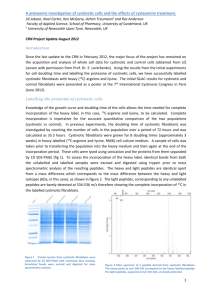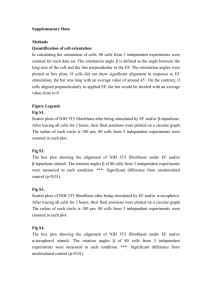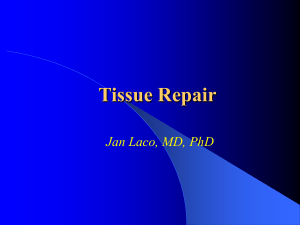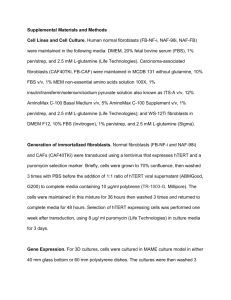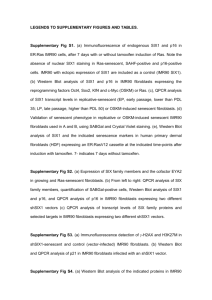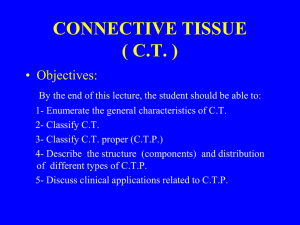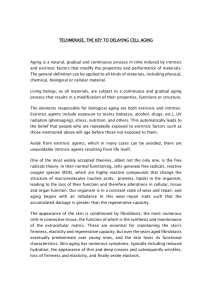The Inflammatory Response in Acyl
advertisement
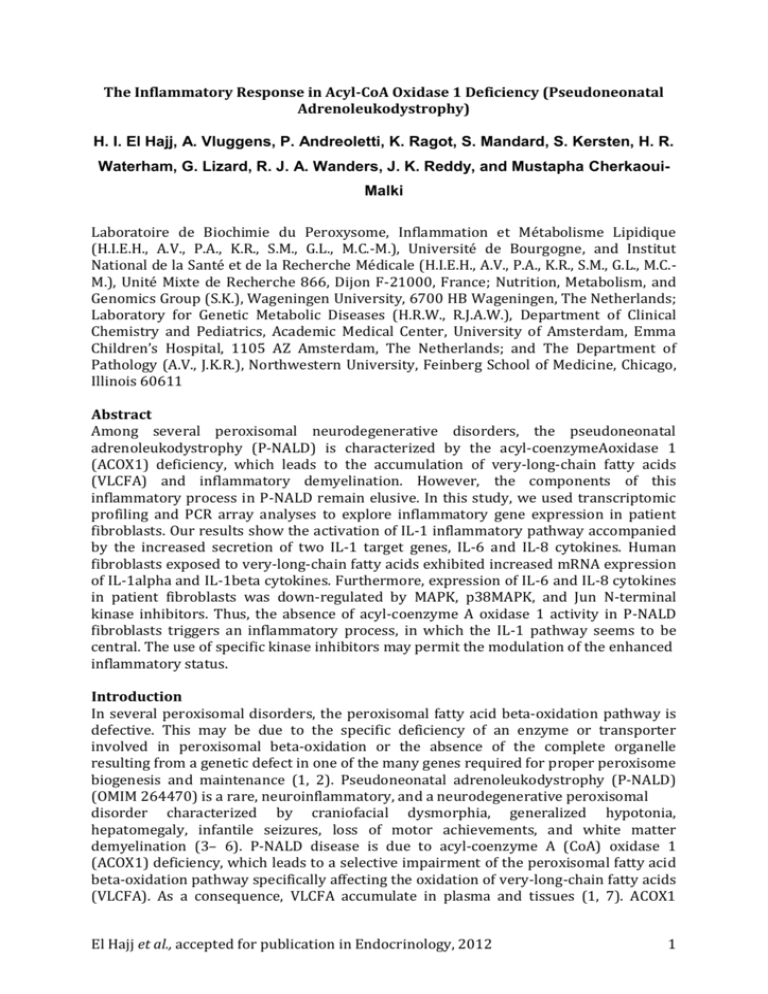
The Inflammatory Response in Acyl-CoA Oxidase 1 Deficiency (Pseudoneonatal Adrenoleukodystrophy) H. I. El Hajj, A. Vluggens, P. Andreoletti, K. Ragot, S. Mandard, S. Kersten, H. R. Waterham, G. Lizard, R. J. A. Wanders, J. K. Reddy, and Mustapha CherkaouiMalki Laboratoire de Biochimie du Peroxysome, Inflammation et Métabolisme Lipidique (H.I.E.H., A.V., P.A., K.R., S.M., G.L., M.C.-M.), Université de Bourgogne, and Institut National de la Santé et de la Recherche Médicale (H.I.E.H., A.V., P.A., K.R., S.M., G.L., M.C.M.), Unité Mixte de Recherche 866, Dijon F-21000, France; Nutrition, Metabolism, and Genomics Group (S.K.), Wageningen University, 6700 HB Wageningen, The Netherlands; Laboratory for Genetic Metabolic Diseases (H.R.W., R.J.A.W.), Department of Clinical Chemistry and Pediatrics, Academic Medical Center, University of Amsterdam, Emma Children’s Hospital, 1105 AZ Amsterdam, The Netherlands; and The Department of Pathology (A.V., J.K.R.), Northwestern University, Feinberg School of Medicine, Chicago, Illinois 60611 Abstract Among several peroxisomal neurodegenerative disorders, the pseudoneonatal adrenoleukodystrophy (P-NALD) is characterized by the acyl-coenzymeAoxidase 1 (ACOX1) deficiency, which leads to the accumulation of very-long-chain fatty acids (VLCFA) and inflammatory demyelination. However, the components of this inflammatory process in P-NALD remain elusive. In this study, we used transcriptomic profiling and PCR array analyses to explore inflammatory gene expression in patient fibroblasts. Our results show the activation of IL-1 inflammatory pathway accompanied by the increased secretion of two IL-1 target genes, IL-6 and IL-8 cytokines. Human fibroblasts exposed to very-long-chain fatty acids exhibited increased mRNA expression of IL-1alpha and IL-1beta cytokines. Furthermore, expression of IL-6 and IL-8 cytokines in patient fibroblasts was down-regulated by MAPK, p38MAPK, and Jun N-terminal kinase inhibitors. Thus, the absence of acyl-coenzyme A oxidase 1 activity in P-NALD fibroblasts triggers an inflammatory process, in which the IL-1 pathway seems to be central. The use of specific kinase inhibitors may permit the modulation of the enhanced inflammatory status. Introduction In several peroxisomal disorders, the peroxisomal fatty acid beta-oxidation pathway is defective. This may be due to the specific deficiency of an enzyme or transporter involved in peroxisomal beta-oxidation or the absence of the complete organelle resulting from a genetic defect in one of the many genes required for proper peroxisome biogenesis and maintenance (1, 2). Pseudoneonatal adrenoleukodystrophy (P-NALD) (OMIM 264470) is a rare, neuroinflammatory, and a neurodegenerative peroxisomal disorder characterized by craniofacial dysmorphia, generalized hypotonia, hepatomegaly, infantile seizures, loss of motor achievements, and white matter demyelination (3– 6). P-NALD disease is due to acyl-coenzyme A (CoA) oxidase 1 (ACOX1) deficiency, which leads to a selective impairment of the peroxisomal fatty acid beta-oxidation pathway specifically affecting the oxidation of very-long-chain fatty acids (VLCFA). As a consequence, VLCFA accumulate in plasma and tissues (1, 7). ACOX1 El Hajj et al., accepted for publication in Endocrinology, 2012 1 catalyzes the alpha, beta-dehydrogenation of a range of acyl-CoA esters, including the CoA-esters of dicarboxylic acids, eicosanoid derivatives, and saturated VLCFA (2, 7, 8). In human and mice, the ACOX1 enzyme is encoded by a single gene, which generates two splice variants, includingexon 3a or exon 3b, respectively, leading to the synthesis of two protein isoforms ACOX1a or ACOX1b (2, 9). Although no apparent genotype-phenotype correlation has been established in P-NALD (7), a patient with a single homozygous mutation on exon 3b has also the clinical signs and symptoms of P-NALD (10), thus revealing the substrate specificity of the specific ACOX1 isoforms (2,8). Mice lacking Acox1 manifest severe inflammatory steatohepatitis with increased intrahepatic H2O2 levels and hepatocellular regeneration (11, 12). Progressively, chronic endoplasmic reticulum stress contributes to hepatocarcinogenesis (13), and this steatoticACOX1null phénotype can be reversed by expression of the human ACOX1b isoform (8, 13). However, even if they show smaller size and growth retardation when compared with their littermates, Acox1 null mice have no apparent neurological disorder (11, 14). In brain lesions of patients developing the demyelinating form of peroxisomal X-linked adrenoleukodystrophy, oxidative, inflammatory, and apoptotic processes have been described (15– 17). In this related peroxisomal disorder, lipid dérivatives with an abnormally high proportion of VLCFA residues have been proposed to trigger the initial cascade of the inflammatory demyelination (18, 19). However, the components of this inflammatory process in P-NALD have remained elusive. To explore the inflammatory response in ACOX1 deficiency, we used two patient-derived fibroblasts for transcriptomic microarray analysis associated with a PCR array screening in an attempt to identify the involved proinflammatory components. In the present work, we report the expression profiling of inflammatory cytokines in fibroblasts from P-NALD patients. Alterations in the expression of IL-1 pathway were revealed and accompanied by increased secretions of the IL-6 and IL-8. Fibroblasts exposed to VLCFA show increased expression of cytokines mRNA. Signaling pathways involved in the induction of these cytokines were also explored. Materials and Methods Cell culture and VLCFA treatment Skin fibroblasts were cultured as described (7) and handled according to national and institutional guidelines. Cerotic acid (C26:0) (Sigma-Aldrich, St. Louis, MO) was solubilized in alpha-cyclodextrine (Sigma-Aldrich). Final concentration of alphacyclodextrine (vehicle) in the culturemediumwas 1 mg/ml. For fibroblasts treatment, the final concentration of C26:0 was 10 microM. Acyl-CoA oxidase activity measurement It was performed as described by Oaxaca-Castillo et al. (2). Immunostaining, fluorescence microscopy, and Nile red staining Immunostaining, fluorescence microscopy, and Nile red staining were achieved as previously described (20). Microarray analysis (Affymetrix, Santa Clara, CA), cytokines analysis by Cytometric Bead Array Human Inflammation kit (BD Biosciences, Courtaboeuf, France), andPCRarray analysis (PAHS- 011; SABiosciences-QIAGEN, Courtaboeuf, France) are described in El Hajj et al., accepted for publication in Endocrinology, 2012 2 Supplemental Materials and Methods, published on The Endocrine Society’s Journals Online web site at http://endo. endojournals.org Results and Discussion Characterization of patient-derived-deficient fibroblasts To characterize the deficiency of ACOX1 in P-NALD fibroblasts, the activity of ACOX1 was first measured in cell extracts. As shown in Fig. 1A, weak residual palmitoyl- CoA oxidase specific activity was present in patient 1 fibroblasts, although much reduced, whereas thisACOX1 activity was undetectable in patient 2 fibroblasts. Both patients’ fibroblast cells exhibited a strong reduction in the number of peroxisomes per cell, as shown by peroxisomes immunostaining with antibodies against catalase (matrix protein) and 70-kDa peroxisomal integral membrane protein (Fig. 1B). This is accompanied by the enlarged size of peroxisomes as shown by anticatalase immunofluorescence (Fig. 1C). Fibroblasts Nile red staining reveals a transition from the predominance of polar lipids in control fibroblasts (green fluorescence) (Fig. 1C) to an accumulation of neutral lipids in P-NALD fibroblasts (yellow fluorescence) (Fig. 1C). Accumulation of VLCFA in plasma has been previously shown for these patients (7). Transcriptomic profiling of inflammatory genes in P-NALD fibroblasts To identify proinflammatory genes that are dysregulated in P-NALD/ACOX1-deficient fibroblasts, we used Affymetrix microarray profiling. Transcriptional profiling revealed that a number of genes coding for cytokines and other proinflammatory proteins was up-regulated (1.5), including, IL-6, IL-8, and several TNFalpha family members (3, 8, 9, 10A, 12, and 14) as well as interferoninducible proteins (Supplemental Table 1). Interestingly, the expression of genes coding for cytokines IL-6, IL-8, and TNFalpha, which are typically produced by macrophages and by CD4+ T cells Th1, has also been found to be increased in multiple sclerosis and cerebral forms of Xadrenoleukodystrophy lesions (15). On the other hand, several cytokines and chemokine mRNA are strongly down-regulated in P-NALD fibroblasts, including chemokine (C-X-C motif) ligand (CXCL)14 and CXCL12 genes, which have been shown to participate in the regulation of cell or tissues homeostasis (21, 22). Alterations of the IL-1beta pathway in P-NALD fibroblasts To define a specific inflammatory pathway activated in ACOX1 deficiency, PCR array (SABiosciences), containing 84 key genes mediating the inflammatory response and which include several genes deregulated in our transcriptomic profiling, was used to determine the profile of reverse- transcribed RNA from the two patients derived fibroblasts compared with the control fibroblasts. Table 1 shows results for genes significantly regulated in both patients. Based on the 2- CT analyses of three PCR arrays (n3) for each fibroblasts sample, 14 genes were strikingly and similarly regulated in ACOX1-deficient fibroblasts for both patients (cut-offs, -1.5-fold gene fold expression 1.5-fold). Absence of ACOX1 activity, which leads to VLCFA accumulation, triggered mRNA up-regulation of IL-1, IL-1, IL-1R1, IL-1RN, IL-17C, secreted phosphoprotein 1 (SPP1), chemokine (C-C motif) receptor type 1 (CCR1), chemokine (CC motif) ligand (CCL)3, CCL7, CAAT/enhancer binding protein (CEBP), and TollEl Hajj et al., accepted for publication in Endocrinology, 2012 3 interacting protein (TOLLIP) (1.65- to 15-fold) and down-regulation of CXCL14, CCL26, and CXCL5 (1.92- to 50-fold). Remarkably, all these regulated genes are connected to the IL-1 pathway. Activation of this pathway is triggered by the binding of the IL-1/IL-1 heterodimer to IL-1R1 (23). Correspondingly, Table 1 shows that IL-1, IL-1, and IL1R1mRNA are significantly induced in P-NALD fibroblasts. Thus, IL-1, which is recognized as a proinflammatory cytokine (24), is known to control the expression of other inflammatory genes, including TNF and interferon through a well-defined transduction signaling pathway (24). In-triguingly, the expression of IL 1RN, an IL-1 receptor antagonist, which modulates the inflammatory responses (23), was induced as well (Table 1). It is noteworthy that IL-1RN is also induced in patient serum developing a neurological disorder, such as schizophrenia (25). We cannot exclude that IL-1RN induction may contribute to the atténuation of the inflammatory stress during P-NALD progression by antagonizing IL-1 activity and thus preserving immune homeostasis (23). Furthermore, another cytokine transcript IL-17C was increased more than 2-fold in both patients derived fibroblasts (Table 1). It is a homologue gene of IL-17, which is increased in autoimmune diseases, such as multiple sclerosis (26). Thus, IL-17C may participates in P-NALD-fibroblasts to the release of both IL-1 and TNF (27). As shown in Table 1, the SPP1 (also called osteopontin) mRNA is highly induced (at least 4-fold) in ACOX1-null fibroblasts. Reportedly, SPP1 expression is induced by IL-1 or IL-1 as well (28, 29). SPP1 is an extracellular glycoprotein, belonging to the integrin superfamily (30). This two-sided mediator acts in a context-dependent manner as a neuroprotectant (31) or as triggering the neuronal toxicity (32) and has been reported in several neurodegenerative diseases, such as multiple sclerosis, Parkinson’s disease, and Alzheimer’s disease (32). Interestingly, in PNALD fibroblasts beside the induction of cytokine mRNA, the expression of several chemokine transcripts (CCL3, CCL7, CCL26, CCR1, CXCL5, and CXCL14) is strongly modified as well (Table 1). Transcripts of both CCR1 and its chemokine ligands CCL3 (Rantes/macrophage inflammatory protein 1) and CCL7 (monocyte chemoattractant protein-3) were highly induced in P-NALD fibroblasts. CCR1 and its ligands play a critical role in the recruitment of inflammatory cells to neurological lesions (33, 34). Hence, infusions of several cell lines with IL-1 or IL-1, including Caco-2, hepatoma, smooth muscle, or astrocytes cell lines (35–38), display enhanced synthesis of CCL3 and/or CCL7, which may interact with its CCR1 receptor. Thus, induction of CCR1 and its ligands in P-NALD-fibroblasts may reflect a common inflammatory response as reported in many neurodegenerative diseases (34, 39). Interestingly, the increased expression of CEBP (2.25- fold) and TOLLIP (mean 2.8-fold) constitutes an additional argument of the activation of the IL-1 inflammatory pathway in P-NALD-fibroblasts (Table 1 and Supplemental Table 1). Hence, enhanced synthesis of CCL3 ligand (Table 1) through the activation IL-1 pathway (as cited above) is dependent on the transcriptional activation of CCL3 gene promoter by CEBP (40). Furthermore, TOLLIP which constitutes an important component of IL-1R signaling pathway (41), can limit the production of proinflammatory cytokines (42) by controlling the magnitude of IL-6 and TNF in response to IL-1beta (43). According to our transcriptomic profiling results (Supplemental Table 1) and using cytometric bead array analysis, we show in Fig. 2 that the secretions of IL-6 and IL-8 cytokines were strongly induced in P-NALD fibroblasts, whereas secretion of TNF was not significantly changed (data not shown). Thus, ACOX1 deficiency in P-NALD fibroblasts leads to the activation of IL-1 inflammatory pathway and enhanced synthesis of its target genes, IL-6 and IL-8 (Fig. 2). El Hajj et al., accepted for publication in Endocrinology, 2012 4 From the 84 genes present in PCR array, only three chemokine genes (i.e. CCL26, CXCL5, and CXCL14) exhibited a similar down-regulation in the two patients derived fibroblasts (Table 1). The CCL26 (or Eotaxin-3) is a strikingly decreased chemokine gene in PNALD-fibroblasts (3.5- to 14-fold) (Table 1). This may be correlated to the induction of CCL3, revealing an autocrine mechanism involving CCL3, which selectively downregulates CCL26 (44). Two other transcripts encoding chemokine ligands were highly decreased in P-NALD fibroblasts, and both belong to the CXCL family. CXCL5 (also called epithelial-derived neutrophil-activating peptide 78) is down-regulated in P-NALD fibroblasts (Table 1) and also in plasma of patients with chronic liver disease and serves as biomarker of necroinflammation and liver fibrosis (45). Hence, P-NALD patients are known to develop hepatomegaly and liver fibrosis (7). Although CXCL14 deficiency has been linked to the attenuation of obesity and brain control of behavior feeding (46). Decreased expression of both CXCL5 and CXCL14 (Table 1) may reflect the dysregulation of lipid metabolism, thus impacting the inflammatory process during PNALD disease progression. Inflammatory response of fibroblasts to increased VLCFA-cerotic acid concentration The increase in the VLCFA levels precede largely the white matter demyelination in PNALD and the neuroinflammatory response in childhood X-linked adrenoleukodystrophy as well (15, 18, 19). Although it is well known that both P-NALD and X-linked adrenoleukodystrophy are associated with the accumulation of VLCFA (1, 8), the direct role of VLCFA in the induction of inflammatory process still is, however, merely speculative (18). To try and understand this possible relationship, we treated control fibroblasts with the cerotic C26:0 fatty acid. Figure 3 shows the time-course expression of cytokines (IL-1alpha, IL-1beta, and IL-6) and ACOX1b, the ACOX1 isoform involved in C26:0-beta-oxidation (2, 8), transcripts in fibroblasts exposed to 10 microM C26:0 during 48 h. As shown in Fig. 3, enhanced cytokines mRNA expression, particularly IL-1alpha and IL-1beta, was evident already between 6 and 12 h, showing a sequential and similar induction with a maximum at 12 h. A return to the control level of both cytokine mRNA at 18 h is concomitant to a delayed ACOX1b mRNA expression hit (Fig. 3). By contrast, 6 h later (a 24-h time course), the expression levels of IL-1alpha and IL-1beta mRNA increased at 24 and 48 h, whereas at the opposite, ACOX1 transcripts were reduced again and stay Under the control threshold at 48 h of VLCFA treatment. Thus, C26:0-VLCFA seems to regulate concomitantly and sequentially, in a divergent manner, both cytokines and ACOX1 mRNA levels. This sequential regulation in fibroblasts is probably linked to the fact that cytokines, such IL-1beta, are able to increase accumulation of VLCFA through inhibition of the peroxisomal beta-oxidation of C26:0-cerotic acid by an unknown mechanism (19). This may install a vicious circle, in which C26:0 fatty acid triggers earlier increase of mRNA cytokines, which downregulate peroxisomal beta-oxidation leading to the accumulation of VLCFA. The latter in turn promotes the reinduction of cytokine transcripts during a second late phase. Signaling pathway involved in cytokines expression To explore the transduced signaling associated with IL-1 pathway activation in P-NALD fibroblasts, we used several known kinase inhibitors and evaluate by cytometry the level of both IL-6 and IL-8 cytokines. In the light of the activation of IL-1 pathway in PNALD/ACOX1-deficient fibroblasts, induced IL-6 is mostly addressed to the medium (Fig. 4A). By using PD 98059, a selective non competitive inhibitor of the MAPK kinase El Hajj et al., accepted for publication in Endocrinology, 2012 5 (MAPKK), we have shown the inhibition of secreted IL-6. This result was confirmed by P-NALD fibroblasts exposure to another MAPKK inhibitor, U0126 (Fig. 4A). Likewise, SB 203580, a highly specific inhibitor of p38 MAPKK, decreased IL-6 secretion as well. Similarly, PD 98059, U0126, and SB 203580 molecules inhibited IL-8 expression in PNALD fibroblasts (Fig. 4). On the other hand, treatment with SP600125 compound, a selective Jun kinases (JNK) inhibitor, exhibited differential effects on IL-6 and IL-8 secretions by decreasing only IL-8 secretion (Fig. 4, A and B). Regarding the activation of IL-1pathway inP-NALD fibroblasts, the induction of IL-8 seems to be dependent on the activation of p38 MAPK and JNK kinase. Hence, IL-1 transduction cascade through these kinases has beenshownfor both IL-8 and CCL3 (47). In addition, the implication of nuclear factor B signaling pathway is not excluded, because C/EBPbeta-dependent transcriptional induction of chemokines by IL1 is triggered through the activation of p38 MAPK and inhibitor of B kinase (40). Accordingly, we also reported (Supplemental Table 1) that themRNAincrease of TNF receptor-associated factor 6, which is known as an IL-1 control relay, functions as signal transducer of inhibitor of B kinase (48). Conclusions Although precise role of VLCFA accumulation in P-NALD demyelination remains to be determined, their ability to induce an inflammatory response adds further evidence to the role of peroxisomal beta-oxidation in the maintenance of cellular homeostasis. Therefore, the reported results in the present report highlight that in P-NALD, ACOX1 deficiency is associated with significant alterations in the inflammatory response leading to the activation of IL-1 pathway. Such activation is triggering the induction of both IL-6 and IL-8 cytokines mostly throughMAPKand p38 MAPKK, in addition to the possible role of JNK kinase in IL-8 induction. Our results also suggested a feed-forward mechanism leading to an additional downregulation of peroxisomal VLCFA beta-oxidation by the produced cytokines, which may aggravates the inflammatory picture in P-NALD. These results open a way to explore the modulation of kinase pathway in an attempt to reduce the inflammatory process in this orphan disease. Acknowledgments We thank Dr. Joseph Vamecq (Institut National de la Santé et de la Recherche Médicale, University of Lille 2, Lille, France) for valuable discussions. Address all correspondence and requests for reprints to: Mustapha Cherkaoui-Malki, Laboratoire de Biochimie du Peroxysome, Inflammation et Métabolisme Lipidique, Université de Bourgogne, 6 Boulevard Gabriel, Dijon F-21000, France. E-mail: malki@u-bourgogne.fr. This work was supported by grants from the Institut National de la Santé et de la Recherche Médicale, the Conseil Régional de Bourgogne, the Ministère de l’Enseignement Supérieur et de la Recherche, and the Centre National de la Recherche Scientifique. Disclosure Summary: The authors have nothing to disclose References El Hajj et al., accepted for publication in Endocrinology, 2012 6 1. Wanders RJ, Waterham HR 2006 Peroxisomal disorders: the single peroxisomal enzyme deficiencies. Biochim Biophys Acta 1763: 1707–1720 2. Oaxaca-Castillo D, Andreoletti P, Vluggens A, Yu S, van Veldhoven PP, Reddy JK, Cherkaoui-Malki M 2007 Biochemical characterization of two functional human liver acyl-CoA oxidase isoforms 1a and 1b encoded by a single gene. Biochem Biophys Res Commun 360:314–319 3. Poll-The BT, Roels F, Ogier H, Scotto J, Vamecq J, Schutgens RB, Wanders RJ, van Roermund CW, van Wijland MJ, Schram AW, Tager JM, Saudubrayet J-M 1988 A new peroxisomal disorder with enlarged peroxisomes and a specific deficiency of acyl-CoA oxidase (pseudo-neonatal adrenoleukodystrophy). Am J Hum Genet 42:422–434 4. Fournier B, Saudubray JM, Benichou B, Lyonnet S, Munnich A, Clevers H, PollThe BT 1994 Large deletion of the peroxisomal acyl-CoA oxidase gene in pseudoneonatal adrenoleukodystrophy. J Clin Invest 94:526–531 5. Suzuki Y, Shimozawa N, Yajima S, Tomatsu S, Kondo N, Nakada Y, Akaboshi S, Lai M, Tanabe Y, Hashimoto T, Wanders RJA, Schutgens RBH, Moser HW, Orii T 1994 Novel subtype of peroxisomal acyl-CoA oxidase deficiency and bifunctional enzyme deficiency with detectable enzyme protein: identification by means of complementation analysis. Am J Hum Genet 54:36–43 6. Guerroui S, Aubourg P, Chen WW, Hashimoto T, Scotto J 1989 Molecular analysis of peroxisomal beta-oxidation enzymes in infants with peroxisomal disorders indicates heterogeneity of the primary defect. Biochem Biophys Res Commun 161:242–251 7. Ferdinandusse S, Denis S, Hogenhout EM, Koster J, van Roermund CW, IJlst L, Moser AB, Wanders RJ, Waterham HR 2007 Clinical, biochemical, and mutational spectrum of peroxisomal acyl-coenzyme A oxidase deficiency. Hum Mutat 28:904–912 8. Vluggens A, Andreoletti P, Viswakarma N, Jia Y, Matsumoto K, Kulik W, Khan M, Huang J, Guo D, Yu S, Sarkar J, Singh I, Rao MS, Wanders RJ, Reddy JK, CherkaouiMalki M 2010 Reversal of mouse Acyl-CoA oxidase 1 (ACOX1) null phenotype by human ACOX1b isoform [corrected]. Lab Invest 90:696–708 9. Varanasi U, ChuR, ChuS, Espinosa R, LeBeauMM, Reddy JK 1994 Isolation of the human peroxisomal acyl-CoA oxidase gene: organization, promoter analysis, and chromosomal localization. Proc Natl Acad Sci USA 91:3107–3111 10. Rosewich H, Waterham HR, Wanders RJ, Ferdinandusse S, Henneke M, Hunneman D, Gärtner J 2006 Pitfall in metabolic screening in a patient with fatal peroxisomal beta-oxidation defect. Neuropediatrics 37:95–98 11. Fan CY, Pan J, Chu R, Lee D, Kluckman KD, Usuda N, Singh I, Yeldandi AV, Rao MS, Maeda N, Reddy JK 1996 Hepatocellular and hepatic peroxisomal alterations in mice with a disrupted peroxisomal fatty acyl-coenzyme A oxidase gene. J Biol Chem 271: 24698–24710 12. Fan CY, Pan J, Usuda N, Yeldandi AV, Rao MS, Reddy JK 1998 Steatohepatitis, spontaneous peroxisome proliferation and liver tumors in mice lacking peroxisomal fatty acyl-CoA oxidase. Implications for peroxisome proliferator-activated receptor alpha natural ligand metabolism. J Biol Chem 273:15639–15645 13. Huang J, Viswakarma N, Yu S, Jia Y, Bai L, Vluggens A, Cherkaoui- Malki M, Khan M, Singh I, Yang G, Rao MS, Borensztajn J, Reddy JK 2011 Progressive endoplasmic reticulum stress contributes to hepatocarcinogenesis in fatty acyl-CoA oxidase 1deficient mice. Am J Pathol 179:703–713 14. Cherkaoui-Malki M, Meyer K, Cao WQ, Latruffe N, Yeldandi AV, Rao MS, Bradfield CA, Reddy JK 2001 Identification of novel peroxisome proliferator-activated El Hajj et al., accepted for publication in Endocrinology, 2012 7 receptor alpha (PPARalpha) target genes in mouse liver using cDNA microarray analysis. Gene Expr 9:291–304 15. McGuinness MC, Griffin DE, Raymond GV, Washington CA, Moser HW, Smith KD 1995 Tumor necrosis factor-alpha and X-linked adrenoleukodystrophy. J Neuroimmunol 61:161–169 16. Paintlia AS, Gilg AG, Khan M, Singh AK, Barbosa E, Singh I 2003 Correlation of very long chain fatty acid accumulation and inflammatory disease progression in childhood X-ALD: implications for potential therapies. Neurobiol Dis 14:425–439 17. Eichler FS, Ren JQ, Cossoy M, Rietsch AM, Nagpal S, Moser AB, Frosch MP, Ransohoff RM 2008 Is microglial apoptosis an early pathogenic change in cerebral Xlinked adrenoleukodystrophy? Ann Neurol 63:729–742 18. Powers JM, Liu Y, Moser AB, Moser HW 1992 The inflammatory myelinopathy of adreno-leukodystrophy: cells, effector molecules, and pathogenetic implications. J Neuropathol Exp Neurol 51:630– 643 19. Khan M, Pahan K, Singh AK, Singh I 1998 Cytokine-induced accumulation of very long-chain fatty acids in rat C6 glial cells: implication for X-adrenoleukodystrophy. J Neurochem 71:78–87 20. Baarine M, Ragot K, Genin EC, El Hajj H, Trompier D, Andreoletti P, Ghandour MS, Menetrier F, Cherkaoui-Malki M, Savary S, Lizard G 2009 Peroxisomal and mitochondrial status of two murine oligodendrocytic cell lines (158N, 158JP): potential models for the study of peroxisomal disorders associated with dysmyelination processes. J Neurochem 111:119–131 21. Meuter S, Schaerli P, Roos RS, Brandau O, Bösl MR, von Andrian UH, Moser B 2007 Murine CXCL14 is dispensable for dendritic cell function and localization within peripheral tissues. Mol Cell Biol 27:983–992 22. Karin N 2010 The multiple faces of CXCL12 (SDF-1) in the regulation of immunity during health and disease. J Leukoc Biol 88: 463–473 23. Allan SM, Rothwell NJ 2001 Cytokines and acute neurodegeneration. Nat Rev Neurosci 2:734–744 24. Dinarello CA 1994 The interleukin-1 family: 10 years of discovery. FASEB J 8:1314– 1325 25. Hope S, Melle I, Aukrust P, Steen NE, Birkenaes AB, Lorentzen S, Agartz I, Ueland T, Andreassen OA 2009 Similar immune profile in bipolar disorder and schizophrenia: selective increase in soluble tumor necrosis factor receptor I and von Willebrand factor. Bipolar Disord 11:726–734 26. Lock C, Hermans G, Pedotti R, Brendolan A, Schadt E, Garren H, Langer-Gould A, Strober S, Cannella B, Allard J, Klonowski P, Austin A, Lad N, Kaminski N, Galli SJ, Oksenberg JR, Raine CS, Heller R, Steinman L 2002 Gene-microarray analysis of multiple sclerosis lesions yields new targets validated in autoimmune encephalomyelitis. Nat Med 8:500–508 27. Li H, Chen J, Huang A, Stinson J, Heldens S, Foster J, Dowd P, Gurney AL, Wood WI 2000 Cloning and characterization of IL-17B and IL-17C, two new members of the IL17 cytokine family. Proc Natl Acad Sci USA 97:773–778 28. Jin CH, Miyaura C, Ishimi Y, Hong MH, Sato T, Abe E, Suda T 1990 Interleukin 1 regulates the expression of osteopontin mRNA by osteoblasts. Mol Cell Endocrinol 74:221–228 29. Lee SK, Park JY, Chung SJ, Yang WS, Kim SB, Park SK, Park JS 1998 Chemokines, osteopontin, ICAM-1 gene expression in cultured rat mesangial cells. J Korean Med Sci 13:165–170 El Hajj et al., accepted for publication in Endocrinology, 2012 8 30. Wang KX, Denhardt DT 2008 Osteopontin: role in immune régulation and stress responses. Cytokine Growth Factor Rev 19:333– 345 31. Meller R, Stevens SL, Minami M, Cameron JA, King S, Rosenzweig H, Doyle K, Lessov NS, Simon RP, Stenzel-Poore MP 2005 Neuroprotection by osteopontin in stroke. J Cereb Blood Flow Metab 25:217–225 32. Carecchio M, Comi C 2011 The role of osteopontin in neurodegenerative diseases. J Alzheimers Dis 25:179–185 33. Skuljec J, Sun H, Pul R, Bénardais K, Ragancokova D, Moharregh- Khiabani D, Kotsiari A, Trebst C, Stangel M 2011 CCL5 induces a pro-inflammatory profile in microglia in vitro. Cell Immunol 270: 164–171 34. Szczuciski A, Losy J 2007 Chemokines and chemokine receptors in multiple sclerosis. Potential targets for new therapies. Acta Neurol Scand 115:137–146 35. Rodriguez-Juan C, Pérez-Blas M, Valeri AP, Aguilera N, Arnaiz- Villena A, Pacheco-Castro A, Martin-Villa JM 2001 Cell surface phenotype and cytokine secretion in Caco-2 cell cultures: increased RANTES production and IL-2 transcription upon stimulation with IL-1. Tissue Cell 33:570–579 36. Lu P, Nakamoto Y, Nemoto-Sasaki Y, Fujii C, Wang H, Hashii M, Ohmoto Y, Kaneko S, Kobayashi K, Mukaida N 2003 Potential interaction between CCR1 and its ligand, CCL3, induced by endogenously produced interleukin-1 in human hepatomas. Am J Pathol 162:1249–1258 37. Ambrosini E, Remoli ME, Giacomini E, Rosicarelli B, Serafini B, Lande R, Aloisi F, Coccia EM 2005 Astrocytes produce dendritic cell-attracting chemokines in vitro and in multiple sclerosis lesions. J Neuropathol Exp Neurol 64:706–715 38. Wuyts WA, Vanaudenaerde BM, Dupont LJ, Demedts MG, Verleden GM 2003 Involvement of p38 MAPK, JNK, p42/p44 ERK and NF-B in IL-1beta-induced chemokine release in human airway smooth muscle cells. Respir Med 97:811–817 39. Xia MQ, Qin SX, Wu LJ, Mackay CR, Hyman BT 1998 Immunohistochemical study of the-chemokine receptors CCR3 and CCR5 and their ligands in normal and Alzheimer’s disease brains. Am J Pathol 153:31–37 40. Zhang Z, Bryan JL, DeLassus E, Chang LW, Liao W, Sandell LJ 2010 CCAAT/Enhancer-binding protein- and NF-B mediate High level expression of chemokine genes CCL3 and CCL4 by human chondrocytes in response to IL-1beta. J Biol Chem 285:33092–33103 41. Burns K, Clatworthy J, Martin L, Martinon F, Plumpton C, Maschera B, Lewis A, Ray K, Tschopp J, Volpe F 2000 Tollip, a new component of the IL-1RI pathway, links IRAK to the IL-1 receptor. Nat Cell Biol 2:346–351 42. Zhang G, Ghosh S 2002 Negative regulation of toll-like receptormediated signaling by Tollip. J Biol Chem 277:7059–7065 43. Didierlaurent A, Brissoni B, Velin D, Aebi N, Tardivel A, Käslin E, Sirard JC, Angelov G, Tschopp J, Burns K 2006 Tollip regulates proinflammatory responses to interleukin-1 and lipopolysaccharide. Mol Cell Biol 26:735–742 44. Abonyo BO, Lebby KD, Tonry JH, Ahmad M, Heiman AS 2006 Modulation of eotaxin-3 (CCL26) in alveolar type II epithelial cells. Cytokine 36:237–244 45. Tacke F, Zimmermann HW, Trautwein C, Schnabl B 2011 CXCL5 plasma levels decrease in patients with chronic liver disease. J Gastroenterol Hepatol 26:523–529 46. Tanegashima K, Okamoto S, Nakayama Y, Taya C, Shitara H, Ishii R, Yonekawa H, Minokoshi Y, Hara T 2010 CXCL14 deficiency in mice attenuates obesity and inhibits feeding behavior in a novel environment. PLoS One 5:e10321 El Hajj et al., accepted for publication in Endocrinology, 2012 9 47. Takemura M, Itoh H, Sagawa N, Yura S, Korita D, Kakui K, Hirota N, Fujii S 2004 Cyclic mechanical stretch augments both interleukin- 8 and monocyte chemotactic protein-3 production in the cultured human uterine cervical fibroblast cells. Mol Hum Reprod 10:573–580 48. Huang Q, Yang J, Lin Y, Walker C, Cheng J, Liu ZG, Su B 2004 Differential regulation of interleukin 1 receptor and Toll-like receptor signaling by MEKK3. Nat Immunol 5:98–103 El Hajj et al., accepted for publication in Endocrinology, 2012 10 Figures El Hajj, Figure 1 Characterization of P-NALD patient’s fibroblasts. A, ACOX1 activity measured in both patients’ (1 and 2) fibroblasts. Enzymatic activity of ACOX1 was measured using palmitoyl-CoA as substrate (2). B, Immunostaining of fibroblasts (control, patient 1 and patient 2 fibroblasts) by catalase, a peroxisomal marker, reveals high number of peroxisomes in control cells and low number of peroxisome in P-NALD patient 1 fibroblasts . C, Immunostaining of control (a) and P-NALD (b) fibroblasts by anticatalase reveals enlarged peroxisome size in patient 1 P-NALDfibroblasts (b). Nile red staining of control (c) and P-NALD (d) fibroblasts. The green color indicates the predominance of polar lipids in control cells, whereas the yellow staining of deficient fibroblasts reveals an accumulation of neutral lipids. Microscope images magnifications, X 100. Scale bar,10 m. PMP70, 70-kDa peroxisomal integral membrane protein. El Hajj et al., accepted for publication in Endocrinology, 2012 11 El Hajj, Figure 2 IL-6 and IL-8 cytokine secretion in the culture medium obtained from the control and PNALD fibroblasts. 1.2 x 106 cells were seeded in 10-cm Petri dishes and cultured in DMEM supplemented with 10% fetal calf serum at 37 C with 5% CO2; 24 h after seeding, fibroblasts were rinsed three times with PBS and incubated in DMEM without serum for 18 h. Culture media were collected and analyzed by cytometric bead array as described in Materials and Methods. Values are mean SD. Fib, Fibroblasts. El Hajj et al., accepted for publication in Endocrinology, 2012 12 El Hajj, Figure 3 Time-course fold inductions of cytokines and ACOX1b mRNA in human control fibroblasts treated with C26:0 at 10 M in -cyclodextrine at final concentration of 1 mg/ml. 1.2 x 106 cells were seeded in 10-cm Petri dishes and cultured in DMEM complemented with 10% fetal calf serum at 37 C with 5% CO2; 24 h after seeding, fibroblasts were rinsed three times with PBS solution and incubated in DMEM with cyclodextrine (1 mg/ml) as control or with -cyclodextrine (1 mg/ml) supplemented with C26:0 at 10 M. Cells were collected at the indicated time point by trypsination. Values are mean SD. Total RNA isolated from treated fibroblasts were analyzed by RTquantitative PCR using El Hajj et al., accepted for publication in Endocrinology, 2012 13 El Hajj, Figure 4A Regulation of IL-6 cytokine in P-NALD fibroblasts by kinases inhibitors. P-NALD fibroblasts were treated with the indicated concentration of kinase inhibitors for 24 h. Culture media and fibroblasts were collected separately. Cells were washed in PBS solution. The media and the cell pellet were deep frozen at -80 C until analysis. Values are mean SD. Statistical significance of higher mean signal intensity (**, P 0.01; *, P 0.05) compared with the control. MEK, MAP kinase or extracellular signalreregulated kinase. El Hajj et al., accepted for publication in Endocrinology, 2012 14 El Hajj, Figure 4B Regulation of IL-8 cytokine in P-NALD fibroblasts by kinases inhibitors. P-NALD fibroblasts were treated with the indicated concentration of kinase inhibitors for 24 h. Culture media and fibroblasts were collected separately. Cells were washed in PBS solution. The media and the cell pellet were deep frozen at -80 C until analysis. Values are mean SD. Statistical significance of higher mean signal intensity (**, P 0.01; *, P 0.05) compared with the control. MEK, MAP kinase or extracellular signalreregulated kinase. El Hajj et al., accepted for publication in Endocrinology, 2012 15 Supplemental Table 1 Table 1: Microarray results of regulated inflammatory genes in P-NALD fibroblasts obtained by Affimetrix profiling. Genes were considered to be significantly changed when raw q-value <0.05 and -1.2>fold-change >1.2. El Hajj et al., accepted for publication in Endocrinology, 2012 16 Supplemental Material and Methods Microarray analysis: Total RNA was extracted from fibroblasts as recommended by the supplier (Qiagen, Courtaboeuf, France). RNA quality was measured on an Agilent 2100 bioanalyzer (Agilent Technologies, Amsterdam, the Netherlands) using 6000 Nano Chips according to manufacturer’s instructions. cRNA synthesis was performed using 5 μg of RNA using one cycle kit (Affymetrix, Santa Clara, CA). Hybridization, washing and scanning of Affymetrix human genome 133 2.0 plus arrays was carried out according to standard Affymetrix protocols. Scans of the Affymetrix arrays were processed using packages from the R/Bioconductor project. Arrays were normalized with quantile normalization and expression levels of probe sets were calculated using the robust multichip average method. Differentially expressed probe sets were identified using Limma and genes were considered to be significantly changed when raw q-value <0.05 and -1.2>fold-change >1.2. Cytokines analysis: Flow cytometric quantification of cytokine secretion with the Cytometric Bead Array (CBA): Culture medium was collected by centrifugation and stored at −80° C. Samples were defrosted and centrifuged immediately before cytokine analysis. IL-8 and IL-6 were quantified using the Cytometric Bead Array Human Inflammation kit according to the supplier instructions (BD Biosciences, Courtaboeuf, France). PCR array analysis : total RNA was isolated as described above. cDNA synthesis and PCR arrays (PAHS-011) were achieved using the RT2 PCR Array First Strand kit and RT² qPCR Master Mixes respectively (SABiosciences-Qiagen, Courtaboeuf, France). PCR arrays including customized primers for 84 key human genes mediating the inflammatory response, five housekeeping genes, 3 RT controls and 3 positive qPCR controls were performed according to the manufacturer's instructions in an iCycler (Bio-Rad, Marnes La Coquette, France). Data analysis was done using the excel analysis tool (www.sabiosciences.com/pcrarraydataanalysis.php), which includes descriptive statistics, including fold change and volcano plots. El Hajj et al., accepted for publication in Endocrinology, 2012 17 El Hajj et al., accepted for publication in Endocrinology, 2012 18 El Hajj et al., accepted for publication in Endocrinology, 2012 19 El Hajj et al., accepted for publication in Endocrinology, 2012 20 El Hajj et al., accepted for publication in Endocrinology, 2012 21 El Hajj et al., accepted for publication in Endocrinology, 2012 22
